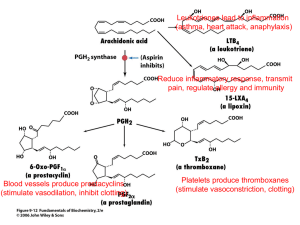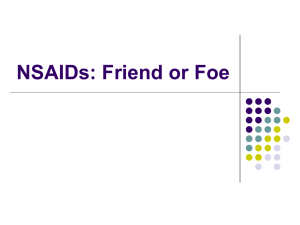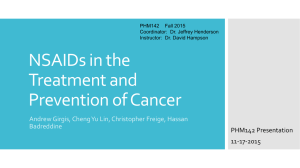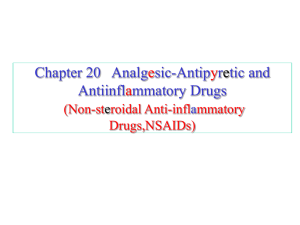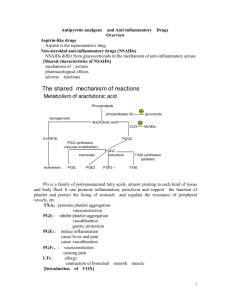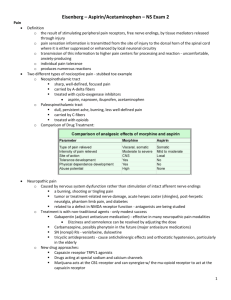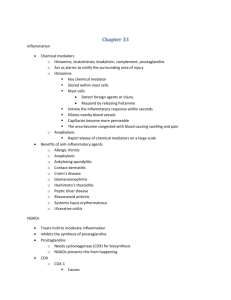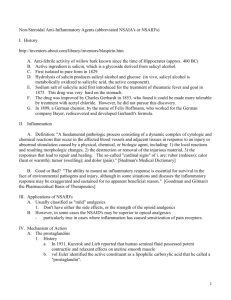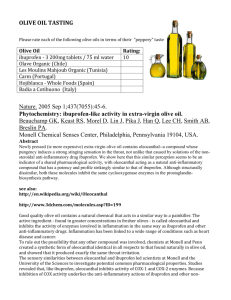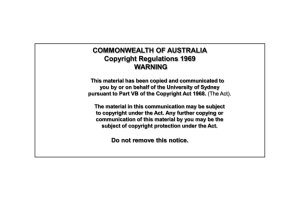Nonsteroidal Anti-inflammatory Drugs (NSAIDs)
advertisement
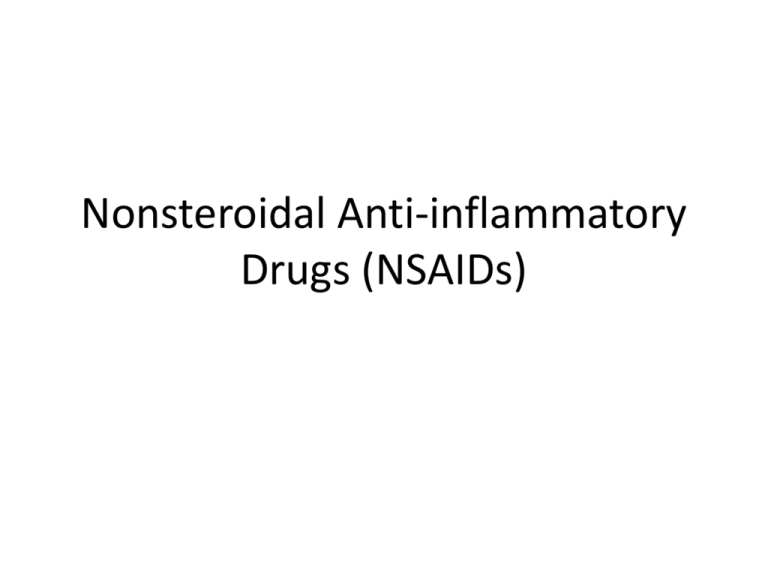
Nonsteroidal Anti-inflammatory Drugs (NSAIDs) • Analgesic • Antipyretic • Anti-inflammatory (at higher doses) Common Pharmacological Effects to be covered below • Analgesic (CNS and peripheral effect) may involve non-PG related effects • Antipyretic (CNS effect) • Anti-inflammatory (except acetaminophen) due mainly to PG inhibition. Some shown to inhibit activation, aggregation, adhesion of neutrophils & release of lysosomal enzymes • Some are Uricosuric Prostaglandin Biosynthesis, Function, and Pharmacologic Inhibition. Control of vascular tone and platelet activation by thromboxanes and prostacyclins Pharmacological Effects (cont’d) • Diverse group of chemicals, but all inhibit cyclooxygenase. • Resultant inhibition of PG synthesis is largely responsible for their therapeutic effects. • But, inhibition of PG synthase in gastric mucosa GIT damage (dyspepsia, gastritis). Common Adverse Effects • Platelet Dysfunction • Gastritis and peptic ulceration with bleeding (inhibition of PG + other effects) • Acute Renal Failure in susceptible • Sodium+ water retention and edema • Analgesic nephropathy • Prolongation of gestation and inhibition of labor. • Hypersenstivity (not immunologic but due to PG inhibition) • GIT bleeding and perforation NSAID Loss of PGI2 induced inhibition of LTB4 mediated endothelial adhesion and activation of neutrophils ↑ Leukocyte-Endothelial Interactions Capillary Obstruction Proteases + Oxygen Radicals Ischemic Cell Injury Endo/Epithelial Cell Injury Mucosal Ulceration Cyclo-oxygenase (COX) • Exists in the tissue as constitutive isoform (COX-1). • At site of inflammation, cytokines stim the induction of the 2nd isoform (COX-2). • Inhibition of COX-2 is thought to be due to the anti-inflammatory actions of NSAIDs. • Inhibition of COX-1 is responsible for their GIT toxicity. • Most currently used NSAIDs are somewhat selective for COX-1, but selective COX-2 inhibitors are available. COX (cont’d) • Celecoxib, etoricoxib, valdecoxib – selective COX-2 inhibitors. • Have similar efficacies to that of the nonselective inhibitors, but the GIT side effects are decr by ~50%. • But, no cardioprotection and there is actually increased MI. The Salicylates - Aspirin • Effect on Respiration: triphasic 1. Low doses: uncoupling phosphorylation → ↑ CO2 → stimulates respiration. 2. Direct stimulation of respiratory center → Hyperventilation → resp. alkalosis → renal compensation 3. Depression of respiratory center and cardiovascular center → ↓ BP, respiratory acidosis, no compensation + metabolic acidosis also The Salicylates - Aspirin • Duration of action ~ 4 hr. • Orally taken. • Weak acid (pKa ~ 3.5); so, non-ionized in stomach easily absorbed. • Hydrolyzed by esterases in tissues and blood to salicylate (active) and acetic acid. • Most salicylate is converted in liver to H2O-sol conjugates that are rapidly excreted by kids. Aspirin • GI system 1. Dose dependent hepatitis 2. Reye’s syndrome • Metabolic 1. Uncoupling of Oxidative Phosphorylation 2. Hyperglycemia and depletion of muscle and hepatic glycogen • Endocrine: corticosteroids, thyroid Cardiovascular • Platelets: Inhibition of platelet COX-1-derived TxA2 with the net effect of increasing bleeding time (inhibition of platelet aggregation) • Endothelial COX-2 derived PGI2 can inhibit platelet aggregation (inhibition augments aggregation by TxA2). Aspirin (acetylsalicylic acid) covalently modifies and, irreversibly inhibits platelet COX. The enzyme is inhibited for the lifetime of the platelet (~8 -11 days). Effect achieved at very low dose. • Basis of therapeutic efficacy in stroke and MI (reduces mortality and prevents recurrent events). Additional Cardiovascular Considerations • Blood vessels/smooth muscle COX-2 derived PGI2 can antagonize catecholamine- and angiotensin II-induced vasoconstriction (NSAIDs can elevate bp). • Atherosclerosis Inhibition of COX-2 can destabilize atherosclerotic plaques (due to its antiinflammatory actions) Renal • COX-1 and COX-2 – generated PGs (TxA2, PGF2 , PGI2 (glom), PGE2 (medulla), powerful vasodilators) can both incr and decr Na+ retention (natriuresis predominates), usually in response to changes in tubular Cl-, extracellular tonicity or low bp. • NSAIDs tend to promote Na+ retention and can therefore increase bp. Can counteract effects of many anti-hypertensives (diuretics, ACE inhibitors and -AR antagonists). • • PGs have minimal impact on normal renal blood flow, but become important in the compromised kidney. Patients (particularly elderly and volume depleted) are at risk of renal ischemia with NSAIDs. Gastrointestinal • PGs (generated via COX-1) 1) inhibit stomach acid secretion, 2) stimulate mucus and HCO3- secretion, vasodilation and therefore, 3) are cytoprotective for the gastric mucosa. • Therefore, NSAIDs with COX-1 inhibitory activity will produce opposite effects, leading to: • Gastric distress, gastric bleeding, sudden acute hemorrhage (effects are dose-dependent) Gestation PGs (generated from COX-2) are involved in the initiation and progression of labor and delivery. Therefore, inhibition of their production by NSAIDs can prolong gestation. Respiratory system High doses (salicylates) cause partial uncoupling of oxidative phosphorylation with increased CO2 production (COX-independent effects). Increase in plasma CO2 hyperventilation. Even higher doses cause depression of respiration. Other uses of NSAIDs (mechanisms less understood) Decreased risk of fatal colon carcinoma Aspirin - Therapeutic Uses • Antipyretic, analgesic • Anti-inflammatory: rheumatic fever, rheumatoid arthritis (joint dis), other rheumatological diseases. High dose needed (5-8 g/day). • But many pts cannot tolerate these doses (GIT); so, proprionic acid derivatives, ibuprofen, naproxen tried first. • Prophylaxis of diseases due to platelet aggregation (CAD, post-op DVT) • Pre-eclampsia and hypertension of pregnancy (?excess TXA2) • Paracetemol (tylenol) – no significant antiinflammatory effect, but used for its mild analgesic effect. • Well-absorbed and without GIT irritation. • Serious disadvantage: at high doses, severe hepatotoxicity results. Mechanisms of Action • Analgesia – both centrally and peripherally. - assoc with anti-inflammatory actions. - results from inhibition of PG synthesis in inflamed tissues. - [PGs little pain relief themselves, but potentiate the pain caused by other mediators of inflammation (e.g., histamine, bradykinin). Mechanisms of Action • Anti-inflammatory action – PGs in inflammation vasodilation and incr vasc permeability. - Inhibition of PGs by NSAIDs attenuates, not abolish, inflammation (NSAIDs do not inhibit mediators of inflammation). - Very modest relief from pain, stiffness, swelling for RA often prescribed for their anti-inflammatory actions. Mechanisms of Action • Antipyretic actions – Fever, heat stroke, incr T° are hypothalamic problems. - So, NSAIDs do not decr body T°. - Fever release of endog pyrogens (e.g., interleukin-1) released from leucocytes acts directly on the thermoregulatory centers in hypothalamus incr body T°. - This is assoc with incr in brain PGs (pyrogenic). - Aspirin prevents the T°-rising effects of interleukin-1 by preventing the incr in brain Mechanism of Action on the Active Site of COX • Possess a long channel (COX-2 channel is wider than in COX-1). • Non-selective NSAIDs enter channel (but not aspirin). • Block channels by binding with H-bonds to an arg half of the way in. • This reversibly inhibits the COX by preventing arachidonic acid from gaining access. • Aspirin acetylates COX (at ser530) and is, therefore, irreversible. • Selective COX-2 inhibitors generally more bulky molecules - can enter and block the channel of COX2, but not that of COX-1. • Paracetamol – reducing cytoplasmic peroxide: • Recall: peroxide is necessary to activate heme enzyme to the Fe. • Acute inflammation: paracetamol is not very effective bec neutrophiles and monocytes produce much H2O2 and lipid peroxide, which overcome the actions of the drug. Selective COX-2 Inhibitors • Anti-inflammatory with less adverse effects, especially GI events. • Potential toxicities: kidney and platelets ? increased risk of thrombotic events. • Assoc with MI and stroke because they do not inhibit platelet aggregation. Thus,.. should not be given to patients with CV disease • Role in Cancer prevention • Role in Alzheimer’s disease Lipoxins – Anti-inflammatory Mediators • During inflammation, cells die by apoptosis. • Lipoxins signal macrophages to clean up. • During the acute inflammatory process, cytokines (e.g., IFN-γ and IL-1β) can induce the expression of anti-inflammatory mediators (lipoxins and IL-4), which promote the resolution phase of inflammation. Generation of Lipoxins by Aspirin Role of Lipoxins in Anti-inflammatory effects of Aspirin Effect of NSAID’s on Platelet-Endothelial Interactions Use of Aspirin in Unstable Angina Use of Aspirin in Unstable Angina Aspirin Toxicity - Salicylism • Headache - timmitus - dizziness – hearing impairment – dim vision • Confusion and drowziness • Sweating and hyperventilation • Nausea, vomiting • Marked acid-base disturbances • Hyperpyrexia • Dehydration • Cardiovascular and respiratory collapse, coma convulsions and death Aspirin Toxicity - Treatment • Decrease absorption - activated charcoal, emetics, gastric lavage • Enhance excretion – ion trapping (alkalinize urine), forced diuresis, hemodialysis • Supportive measures - fluids, decrease temperature, bicarbonate, electrolytes, glucose, etc… Other NSAIDs • Phenylbutazone: additional uricosuric effect. Aplastic anemia. • Indomethacin: Common adverse rxns: gastric bleeding, ulceration, CNS most common: hallucinations, depression, seizures, headaches, dizziness. • Proprionic acids: better tolerated. Differ in pharmacokinetics; ibuprofen, fenbufen, naproxen widely used for inflammatory joint disease and few side-effects. • Acetaminophen: differs in effects and adverse rxn from rest. Main toxicity: hepatitis due to toxic intermediate which depletes glutathione. Treat with N-acetylcysteine. Attempts to Decrease Toxicity of NSAID’s – Nitroaspirins Rates per 100 Patient-Years VIGOR - Summary of GI Endpoints Rofecoxib Naproxen RR: 0.46† (0.33, 0.64) 5 RR: 0.38† (0.25, 0.57) 4 RR: 0.43* (0.24, 0.78) 3 2 1 0 †p < 0.001. Confirmed Clinical Upper GI Events Confirmed Complicated Upper GI Events All Clinical GI Bleeding * p = 0.005. ( ) = 95% CI. Source: Bombardier, et al. N Engl J Med. 2000. VIGOR - Confirmed Thrombotic Cardiovascular Events Patients with Events (Rates per 100 Patient-Years) Rofecoxib N=4047 Naproxen N=4029 Confirmed CV events 45 (1.7) 19 (0.7) 0.42 (0.25, 0.72) Cardiac events 28 (1.0) 10 (0.4) 0.36 (0.17, 0.74) Cerebrovascular events 11 (0.4) 8 (0.3) 0.73 (0.29, 1.80) Peripheral vascular events 6 (0.2) 1 (0.04) 0.17 (0.00, 1.37) Event Category Relative Risk (95% CI) Source: Data on file, MSD Effect of Celecoxib & Rofecoxib on PGIM Urinary PGI-M (pg/mg creatinine) (Mean ± SE) Urinary 2,3 dinor-6-keto-PGF1a (PGIM) 200 Single Dose Rx† 200 160 160 120 120 80 40 0 * p<0.05 vs. placebo. **p<0.01 vs. placebo. * ** Two Weeks Rx†† 80 ** ** 40 Placebo Celecoxib Ibuprofen N=7 400 mg 800 mg N=7 N=7 † 0 Placebo N=12 Rofecoxib Indomethacin 50 mg QD 50 mg TID N=12 N=10 Proc. Natl. Acad Sci. USA 1999;96:272-277. †† J. Pharmacol. Exp. Ther. 1999;289:735-741. Investigator-Reported Thrombotic Cardiovascular Events in the VIGOR Study Compared with Phase IIb/III OA Study Cumulative Incidence % 3.5 3.0 Rofecoxib (VIGOR) 2.5 Ibuprofen, Diclofenac, Nabumetone (OA) 2.0 Rofecoxib (OA) 1.5 Naproxen (VIGOR) 1.0 0.5 0.0 0 2 4 6 8 10 Months of Follow-up 12 14 FDA files Gout • Characterized by deposition of Na urate crystals in the joint painful arthritis. • Acute attacks treated with indomethecin, naproxen, or other NSAIDs, but not with aspirin (incr plasma urate levels at low doses by inhibiting uric acid secretion in the renal tubules). • Colchicine – bonds tubulin in leukocytes prevents polymerization in microtubules inhibits the phagocytic activity and migration of leukocytes to the area of uric acid deposition decr inflammatory repsonse. Prophylactic treatment of Gout • Allopurinol lowers plasma urate by inhibiting xanthine oxidase (xanthine uric acid). • Uricosuric drugs (sulfinpyrazone, probenicid) inhibit renal tubular reabsorption of uric acid incr excretion. • Should drink plenty of H2O to prevent crystallization of urate in the urine. • These drugs less effective and more toxic than allopurinol. Treatment of Gout
